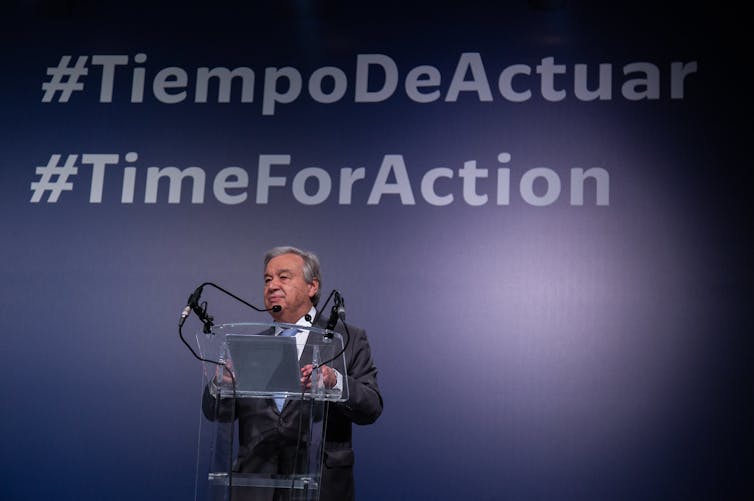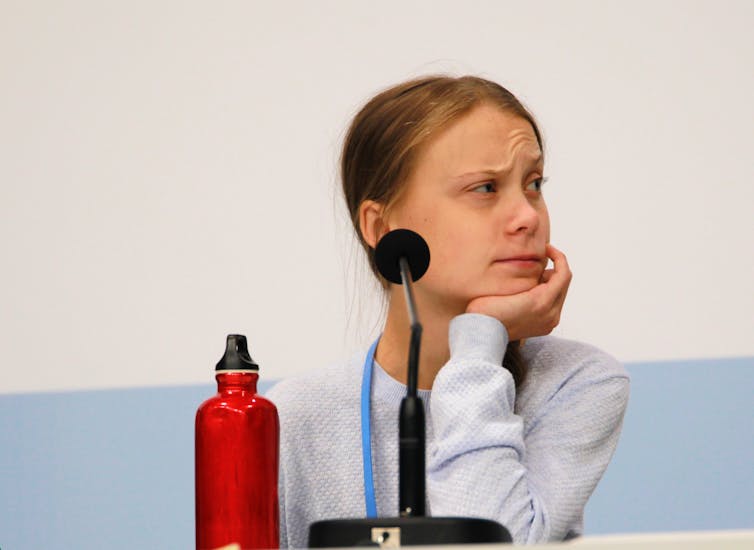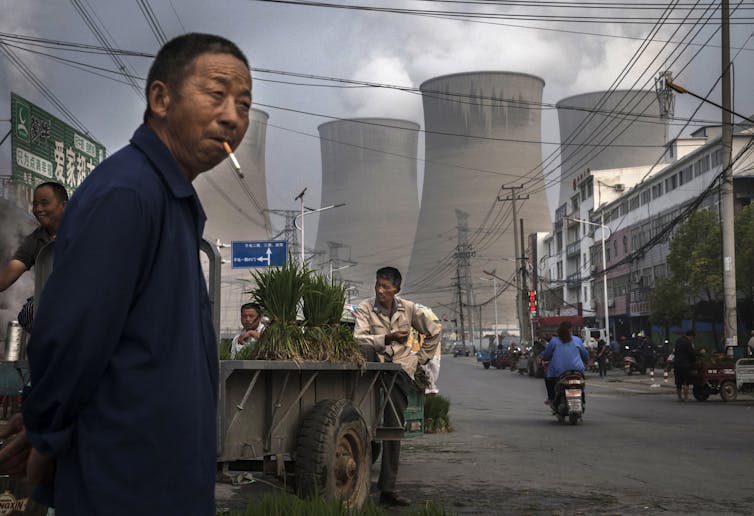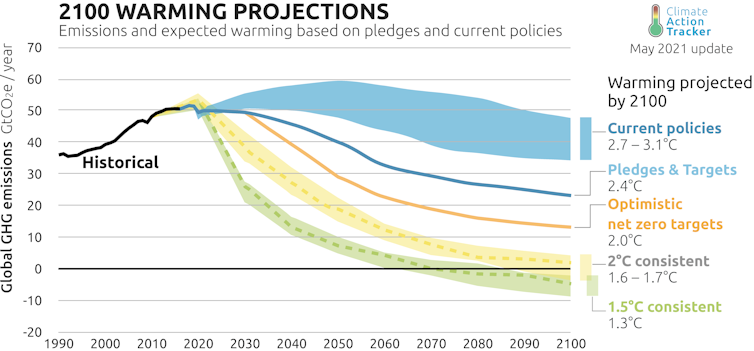I worked for the United Nations for several years as a law and policy adviser and have been involved in international negotiations. Here’s what’s happening behind closed doors and why people are concerned that COP26 might not meet its goals.
What is COP26?
In 1992, countries agreed to an international treaty called the United Nations Framework Convention on Climate Change (UNFCCC), which set ground rules and expectations for global cooperation on combating climate change. It was the first time the majority of nations formally recognized the need to control greenhouse gas emissions, which cause global warming that drives climate change.
That treaty has since been updated, including in 2015 when nations signed the Paris climate agreement. That agreement set the goal of limiting global warming to “well below” 2 degrees Celsius (3.6 F), and preferably to 1.5 C (2.7 F), to avoid catastrophic climate change.
COP26 stands for the 26th Conference of Parties to the UNFCCC. The “parties” are the 196 countries that ratified the treaty plus the European Union. The United Kingdom, partnering with Italy, is hosting COP26 in Glasgow, Scotland, from Oct. 31 through Nov. 12, 2021, after a one-year postponement due to the COVID-19 pandemic.
Why are world leaders so focused on climate change?
The U.N. Intergovernmental Panel on Climate Change’s latest report, released in August 2021, warns in its strongest terms yet that human activities have unequivocally warmed the planet, and that climate change is now widespread, rapid and intensifying.
The IPCC’s scientists explain how climate change has been fueling extreme weather events and flooding, severe heat waves and droughts, loss and extinction of species, and the melting of ice sheets and rising of sea levels. U.N. Secretary-General António Guterres called the report a “code red for humanity.”
Enough greenhouse gas emissions are already in the atmosphere, and they stay there long enough, that even under the most ambitious scenario of countries quickly reducing their emissions, the world will experience rising temperatures through at least mid-century.
However, there remains a narrow window of opportunity. If countries can cut global emissions to “net zero” by 2050, that could bring warming back to under 1.5 C in the second half of the 21st century. How to get closer to that course is what leaders and negotiators are discussing.

What happens at COP26?
During the first days of the conference, around 120 heads of state, like U.S. President Joe Biden, and their representatives will gather to demonstrate their political commitment to slowing climate change.
Once the heads of state depart, country delegations, often led by ministers of environment, engage in days of negotiations, events and exchanges to adopt their positions, make new pledges and join new initiatives. These interactions are based on months of prior discussions, policy papers and proposals prepared by groups of states, U.N. staff and other experts.
Nongovernmental organizations and business leaders also attend the conference, and COP26 has a public side with sessions focused on topics such as the impact of climate change on small island states, forests or agriculture, as well as exhibitions and other events.
The meeting ends with an outcome text that all countries agree to. Guterres publicly expressed disappointment with the COP25 outcome, and there are signs of trouble heading into COP26.

What is COP26 expected to accomplish?
Countries are required under the Paris Agreement to update their national climate action plans every five years, including at COP26. This year, they’re expected to have ambitious targets through 2030. These are known as nationally determined contributions, or NDCs.
The Paris Agreement requires countries to report their NDCs, but it allows them leeway in determining how they reduce their greenhouse gas emissions. The initial set of emission reduction targets in 2015 was far too weak to limit global warming to 1.5 degrees Celsius.
One key goal of COP26 is to ratchet up these targets to reach net zero carbon emissions by the middle of the century.
Another aim of COP26 is to increase climate finance to help poorer countries transition to clean energy and adapt to climate change. This is an important issue of justice for many developing countries whose people bear the largest burden from climate change but have contributed least to it. Wealthy countries promised in 2009 to contribute $100 billion a year by 2020 to help developing nations, a goal that has not been reached. The U.S., U.K. and EU, among the largest historic greenhouse emitters, are increasing their financial commitments, and banks, businesses, insurers and private investors are being asked to do more.
Other objectives include phasing out coal use and generating solutions that preserve, restore or regenerate natural carbon sinks, such as forests.
Another challenge that has derailed past COPs is agreeing on implementing a carbon trading system outlined in the Paris Agreement.

Are countries on track to meet the international climate goals?
The U.N. warned in September 2021 that countries’ revised targets were too weak and would leave the world on pace to warm 2.7 C (4.9 F) by the end of the century. However, governments are also facing another challenge this fall that could affect how they respond: Energy supply shortages have left Europe and China with price spikes for natural gas, coal and oil.
China – the world’s largest emitter – submitted an updated NDC on Oct. 28 with little change from pledges it announced almost a year ago. Major fossil fuel producers such as Russia and Australia seem unwilling to strengthen their commitments. Saudi Arabia strengthened its targets but doesn’t count exports of oil and gas, which it says it will continue producing. India – a critical player as the second-largest consumer, producer and importer of coal globally – has also not yet committed.
Other developing nations such as Indonesia, Malaysia, South Africa and Mexico are important. So is Brazil, which, under Jair Bolsonaro’s watch, has increased deforestation of the Amazon – the world’s largest rainforest and crucial for biodiversity and removing carbon dioxide from the atmosphere.
What happens if COP26 doesn’t meet its goals?
Many insiders believe that COP26 won’t reach its goal of having strong enough commitments from countries to cut global greenhouse gas emissions 45% by 2030. That means the world won’t be on a smooth course for reaching net-zero emissions by 2050 and the goal of keeping warming under 1.5 C.
But organizers maintain that keeping warming under 1.5 C is still possible. Former Secretary of State John Kerry, who has been leading the U.S. negotiations, remains hopeful that enough countries will create momentum for others to strengthen their reduction targets by 2025.

The cost of failure is astronomical. Studies have shown that the difference between 1.5 and 2 degrees Celsius can mean the submersion of small island states, the death of coral reefs, extreme heat waves, flooding and wildfires, and pervasive crop failure.
That translates into many premature deaths, more mass migration, major economic losses, large swaths of unlivable land and violent conflict over resources and food – what the U.N. secretary-general has called “a hellish future.”
[Get The Conversation’s most important politics headlines, in our Politics Weekly newsletter.]
This article was updated Oct. 29, 2021, with China and Saudi Arabia submitting their NDCs.

Aucun commentaire:
Enregistrer un commentaire
Ce blog est ouvert à la contradiction par la voie de commentaires. Je tiens ce blog depuis fin 2005; je n'ai aucune ambition ni politique ni de notoriété. C'est mon travail de retraité pour la collectivité. Tout lecteur peut commenter sous email google valide. Tout peut être écrit mais dans le respect de la liberté de penser de chacun et la courtoisie.
- Je modère tous les commentaires pour éviter le spam et d'autres entrées malheureuses possibles.
- Cela peut prendre un certain temps avant que votre commentaire n'apparaisse, surtout si je suis en déplacement.
- Je n'autorise pas les attaques personnelles. Je considère cependant que ces attaques sont différentes des attaques contre des idées soutenues par des personnes. Si vous souhaitez attaquer des idées, c'est bien, mais vous devez alors fournir des arguments et vous engager dans la discussion.
- Je n'autorise pas les commentaires susceptibles d'être diffamatoires (au mieux que je puisse juger car je ne suis pas juriste) ou qui utilisent un langage excessif qui n'est pas nécessaire pour l'argumentation présentée.
- Veuillez ne pas publier de liens vers des publicités - le commentaire sera simplement supprimé.
- Je suis pour la liberté d'expression, mais il faut être pertinent. La pertinence est mesurée par la façon dont le commentaire s'apparente au sujet du billet auquel le commentaire s'adresse. Si vous voulez juste parler de quelque chose, créez votre propre blog. Mais puisqu'il s'agit de mon blog, je vous invite à partager mon point de vue ou à rebondir sur les points de vue enregistrés par d'autres commentaires. Pour ou contre c'est bien.
- Je considère aussi que la liberté d'expression porte la responsabilité d'être le propriétaire de cette parole.
J'ai noté que ceux qui tombent dans les attaques personnelles (que je supprime) le font de manière anonyme... Ensuite, ils ont l'audace de suggérer que j'exerce la censure.